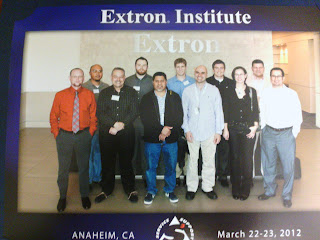"Daddy, do any girls work with you," -- Chloe, age 5 on the eve of Take Your Children to Work day (see earlier blog post)
I work, as you know, in the wonderful world of commercial AV, spreading the joys of audio-visual technology throughout the land. I've worked for two different integrators, worked for scores of clients including Fortune 100 companies with their own internal AV support staff.
Of team with whom I currently work?
Installation technicians - all male.
Service technicians - all male
Project engineers - all male.
Design engineers and sales engineers - all male.
Programmers - all male.
Project specialists (testing and verification technicians) - all male.
CAD technician - female.
That's right. Of the twentysome people in various technical positions in our local office, there is exactly one female in a technical role.
 |
| Scenes from a day of AV Training |
Lest you think this a local problem in the past six months alone I've taken part in vendor training from Biamp, ClearOne, Extron, Crestron, AVI-SPL's in-house AV Project Management training, Crestron again, and Meyer sound. Those training classes alone represent contact with somewhere between a hundred and a hundred fifty of my fellow AV professionals.
Of those, exactly one was a woman.
 |
| At Extron Training - this was the highest female/male ratio of any training I attended this year |
The second problem is one for the industry; we rob ourselves of half the potential talent available by closing the door to half the population. This is a truism for all industries; greater diversity of candidates breeds greater diversity of viewpoints and, in the long term, better results.
So what do do about it? The good news is that the culture is changing, from greater acceptance to less of a "boys' club" atmosphere. For example, most AV professionals today are reluctant to use sexually suggestive test media when commissioning a system. It is worth noting that at least two of AVI-SPL's local offices are being run by women. I'm very proud that the Women in AV group (an industry group of some very talented and successful people working towards mentoring and promotion of women in the industry) chose one of our account managers (Alexis LaBroi from the Atlanta office) for their inaugural mentoring award. Having women not only in leadership positions in the industry but using those positions to help others follow in their footsteps is one step towards a more inclusive industry. It's the slow, organic way to grow.
Are there wider, better solutions possible? That's very hard for me to say. I suspect it would take an overall change in how we look at men and women for the AV industry - or any technology industry - to become truly gender blind. It's still an ideal worth fighting for and one towards which we're currently - albeit it slowly - working.
Great article Leonard and thank you for broaching the subject ;)
ReplyDeleteLeonard: Nice work! Anecdotal observations may be all we have here and mine are similar to yours, but I'd be interested to know if there are actual numbers. If not, is there a practical way for WAVE to generate them? If we actually knew, would that be a basis for a WAVE initiative to improve the situation?
ReplyDeleteKelly: Thanks for the kind words and for passing this along!
ReplyDeleteBill: That is an excellent point. I'm not in a position to give much more than a "from the ground" perspective, but actual statistics would say more. If there were an easy way to sort Infocomm's directory of CTS holders by gender (there does not appear to be) that would probably be a good start.
I actually enjoyed reading through this posting.Many thanks.
ReplyDeleteProject Management Training